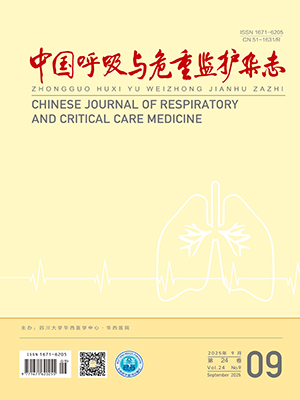| 1. |
Sontheimer RD. Cutaneous features of classic dermatomyositis and amyopathic dermatomyositis. Curr Opin Rheumatol, 1999, 11(6): 475-482.
|
| 2. |
韩磊, 吕良敬. 无肌病性皮肌炎的研究进展. 中华风湿病学杂志, 2011, 15(11): 795-797.
|
| 3. |
Sun Y, Liu Y, Yan B, et al. Interstitial lung disease in clinically amyopathic dermatomyositis (CADM) patients: a retrospective study of 41 Chinese Han patients. Rheumatol Int, 2013, 33(5): 1295-1302.
|
| 4. |
Li XR, Peng SC, Wei LQ. Nonspecific interstitial pneumonia overlaps organizing pneumonia in lung-dominant connective tissue disease. Int J Clin Exp Pathol, 2015, 8(9): 11230-11235.
|
| 5. |
中华医学会风湿病学分会. 多发性肌炎和皮肌炎诊断及治疗指南. 中华风湿病学杂志, 2010, 14(12): 828-831.
|
| 6. |
Bradley B, Branley HM, Egan JJ, et al. Interstitial Lung Disease Guideline: the British Thoracic Society in Collaboration with the Thoracic Society of Australia and New Zealand and the Irish Thoracic Society. Thorax, 2008, 63(Suppl 5): v1-v58.
|
| 7. |
Travis WD, Costabel U, Hansell DM, et al. An official American Thoracic Society/European Respiratory Society Statement: Update of the International Multidisciplinary Classification of the Idiopathic Interstitial Pneumonias. Am J Respir Crit Care Med, 2013, 188(6): 733-748.
|
| 8. |
Lynch DA, Godwin JD, Safrin S, et al. High-resolution computed tomography in idiopathic pulmonary fibrosis: diagnosis and prognosis. Am J Respir Crit Care Med, 2005, 172(4): 488-493.
|
| 9. |
徐凌, 沈策. 机化性肺炎的研究进展. 国际呼吸杂志, 2007, 27(24): 1903-1906.
|
| 10. |
董馨, 郑毅, 王丽, 等. 结缔组织病相关性机化性肺炎的临床特点. 中华风湿病学杂志, 2015, 19(6): 374-379.
|
| 11. |
沈敏, 龚瑜林, 曾小峰, 等. 以间质性肺疾病起病的皮肌炎临床特点分析. 中华医学杂志, 2014, 94(43): 3402-3406.
|
| 12. |
Hayashi S, Tanaka M, Kobayashi H, et al. High-resolution computed tomography characterization of interstitial lung diseases in polymyositis/dermatomyositis. J Rheumatol, 2008, 35(2): 260-269.
|
| 13. |
Tsuchiya Y, Fischer A, Solomon JJ, et al. Connective tissue disease-related thoracic disease. Clin Chest Med, 2015, 36(2): 283-297.
|




